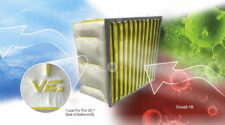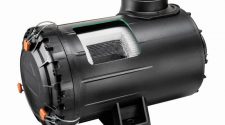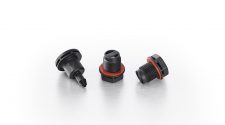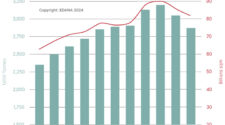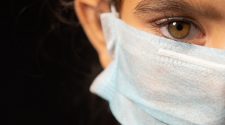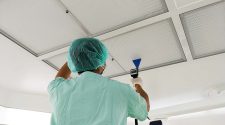Under the guidance of Prof. Danmeng Shuai and Prof. Yun Shen, Hongchen Shen and Zhe Zhou are working on their Ph.D. studies within the School of Engineering & Applied Science/Department of Civil & Environmental Engineering at The George Washington University. Their work is focused on leveraging nanotechnology for controlling environmental pathogens.
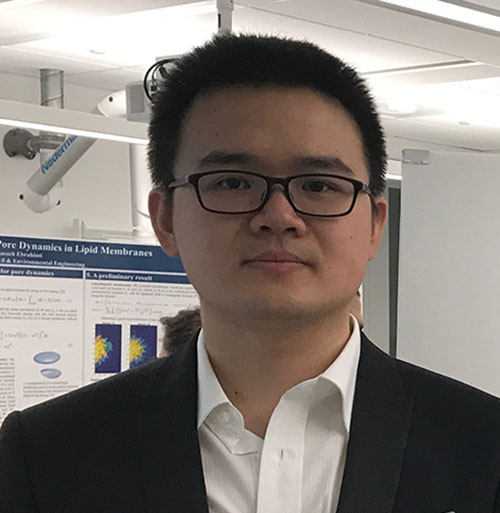
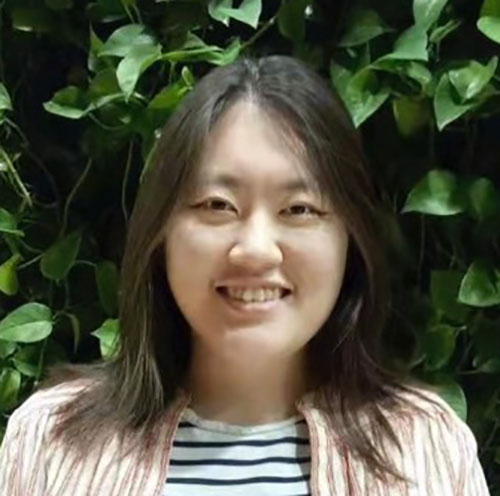
Currently, they are carrying out a project on utilizing electrospun nanofibrous air filters to control the airborne transmission of SARS-CoV-2, the pathogen causing COVID-19. The serious health risks of environmental pathogens in water, air and on contact surfaces has driven the team to investigate novel techniques for pollution mitigation. As part of their research, Hongchen and Zhe aim to leverage nanotechnology in order to improve the performance, efficiency and feasibility of the air filtration system for removing SARS-CoV-2.
Research overview
SARS-CoV-2 can spread through multiple pathways, e.g., contact transmission, fomite transmission and airborne transmission. Among all the transmission pathways, airborne transmission, or transmission via aerosols, has raised huge health concerns because these aerosols are everywhere and hard to control.
Indeed, PVDF20 and PVDF300 air filters showed 99.1% and 99.9% of coronavirus aerosol filtration efficiency on average, respectively, while the positively-coated PVDF20/PEI air filters did not enhance the removal efficiency of coronavirus aerosol (99.1 %) and negatively-coated PVDF20/PVPA air filters showed a lower filtration efficiency of 95.7 % on average.
The general public often uses homemade cloth masks to protect themselves. However, these cloth masks are not designed for the removal of viral aerosols and thus fail to meet the satisfactory aerosol filtration efficiency. Therefore, there is a pressing need to develop novel, highly efficient aerosol filtration membranes for different applications.
For comparison, two commercially available masks – a neck gaiter and a cotton mask – and one surgical mask were selected as reference. All the membrane samples were characterized by scanning electron microscopy (SEM). The electrospun membrane possessed the smallest fiber diameter and pore size (~300 nm, ~2.7 μm, Figure 1). Next, the aerosol filtration efficiency for all the membranes was tested by a customized aerosolization setup (CH Technologies, Inc.). The aerosols were first generated by a BLAM Aerosol Generator (Figure 2). A part of aerosols went through the filter holder in which membrane samples were installed. The aerosols escaping from the membranes were captured by the liquid in the Impinger. It is worth noting that in this study two kinds of aerosols were generated and used in the filtration tests, i.e., murine hepatitis virus A59 (MHV-A59) aerosols and NaCl aerosols. Besides NaCl aerosols, which are frequently used in aerosol studies, MHV-A59, which is similar to SARS-CoV-2 in both structure and size, could perfectly simulate the behaviors of SARS-CoV-2 in the aerosol filtration tests. In addition, it is much safer to use MHV instead of SARS-CoV-2.
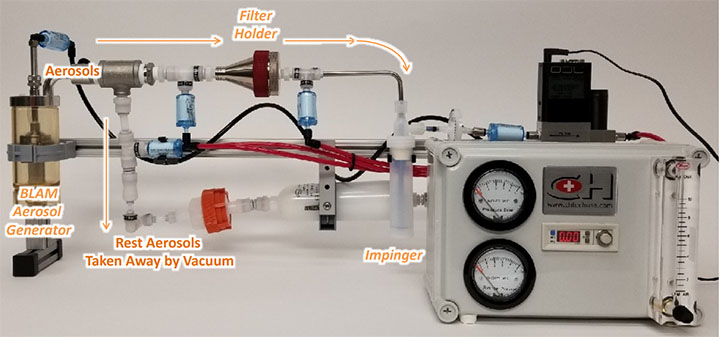
Electrospinning is an emerging approach using electrostatic forces to produce ultrafine nanofibers by the extrusion of a polymer solution and thus a larger surface area would be obtained. By using electrospinning technology, Hongchen and Zhe were able to develop nonwoven nanofibrous air filters for effectively capturing coronavirus aerosols generated from the MHV-A59, a surrogate for SARS-CoV-2.
In their study, Hongchen and Zhe fabricated several electrospun air filters including pristine polyvinylidene fluoride ones (PVDF20 and PVDF30), a positively charged polyethylenimine coated PVDF one (PVDF20/PEI), and a negatively charged polyvinylphosphonic acid coated PVDF one (PVDF20/PVPA). By introducing different electric-charged polyelectrolytes onto pristine PVDF air filters, the goal was to investigate whether the electrostatic interaction (attraction and repulsion) would significantly influence the coronavirus aerosol filtration efficiency. To determine the coronavirus aerosol filtration efficiency of our electrospun nanofibrous air filters, the coronavirus captured by the membranes and escaped from the membranes was quantified by reverse transcription quantitative polymerase chain reaction (RT-qPCR).
Since the smaller fiber diameter would provide a larger specific surface to enhance interception, inertial impaction, and diffusion for aerosol capture, Hongchen and Zhe expected the electrospun nanofibrous air filters would outperform the commercial masks in coronavirus aerosol removal. Indeed, PVDF20 and PVDF30 air filters showed 99.1 % and 99.9% of coronavirus aerosol filtration efficiency on average, respectively, while the positively charged PVDF20/PEI air filters did not enhance the removal efficiency of coronavirus aerosol (99.1 %) and negatively charged PVDF20/PVPA air filters showed a lower filtration efficiency of 95.7 % on average (Figure 3).
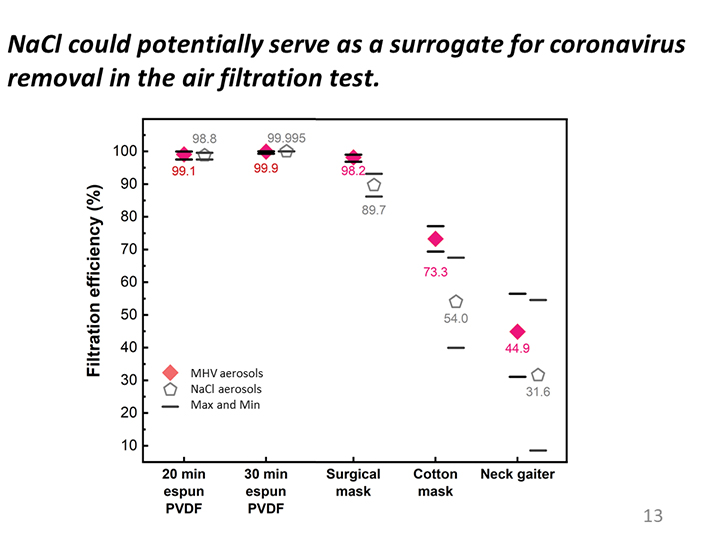
These results indicated that electrostatic attraction might not play a critical role in coronavirus aerosol capture, and electrostatic repulsion would affect aerosol filtration efficiency if it were assumed that coronavirus aerosols were negatively charged in the study.
The study demonstrated that electrospun nanofibrous air filters showed desirable coronavirus aerosol filtration performance, providing protection against airborne transmission of infectious pathogen particles. The electrospinning technique is attractive in diverse applications because the produced ultrafine nanofibers can be easily functionalized, and the investigators are looking forward to advancing the design of reactive filtration for air pollution control and to protecting the public health.
In addition, this research is the first study to use coronavirus aerosols for investigating the aerosol filtration efficiency. NaCl could potentially serve as a surrogate for coronavirus removal in the air filtration tests, but more studies are needed.
Career goals
In the near future, Hongchen and Zhe will use the electrospinning technique to fabricate some reactive air filters to boost the coronavirus control.
As a fifth year Ph.D. candidate, Hongchen is working on his thesis and looking for a postdoctoral position. He hopes to find a position where he can perform cutting-edge research, utilizing his expertise, including synthesizing, characterizing, and applying (bio)nanomaterials, inactivating foodborne, waterborne, and airborne pathogens, and understanding pathogen-nanomaterial interactions with advanced microscopic, spectroscopic, and omics tools.
After finishing his postdoctoral training, Hongchen plans to find a position in academia. As a professor, he will be mainly focused on resolving environmental issues, e.g., pollution, natural resource depletion, and global warming. He is also excited to help students achieve their career goals, just as his advisor has done for him.
Zhe will be investigating the interactions between materials and environmental pollutants, including emerging contaminants and pathogens. Zhe is also interested in the fate of pathogens in natural water system. As a junior Ph.D. student, Zhe still has some work to do before achieving her ultimate goal of becoming an environmental engineer.


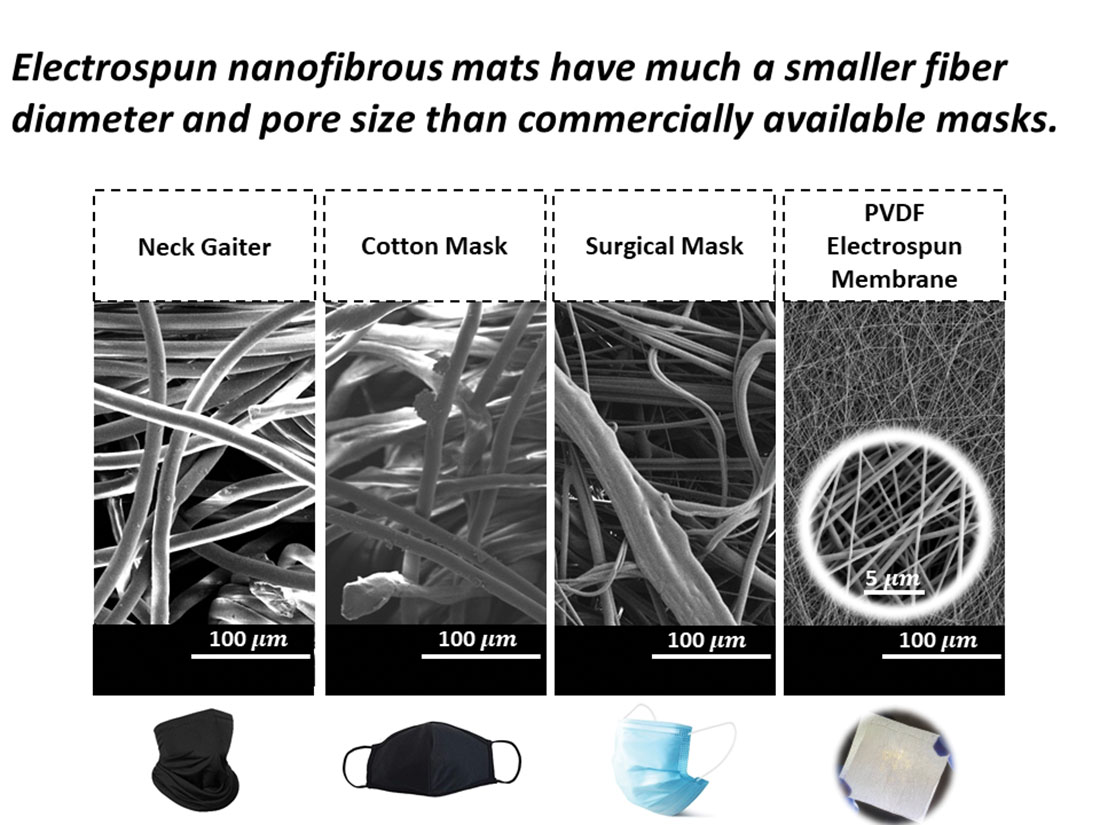
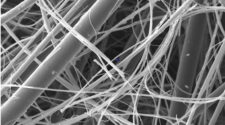
![Figure 1: Heat Exchanger Proventics GMBH.[22]](https://www.filtnews.com/wp-content/uploads/IFN_2_2024_crimpedmicrofiberyarns_Fig.-1-Heat-exchanger-225x125.jpg)

